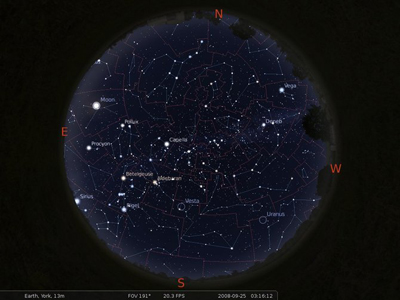Telescopes and binoculars are pretty useless unless you know where to point them. I am going to show you some standard constellations and how to find them in the night sky, so you’ll never be lost again in the ocean of stars overhead. We’re going to learn how to go star gazing using planetarium software, and how to customize to your location in the world so you know what you’re looking at when you look up into the sky tonight!
Please login or register to read the rest of this content.


It sounds like you may have downloaded the picture of a completed star wheel, instead of the two separate parts needed to make your own. Once you click on the link that takes you to Sky & Telescope, scroll down to the part that says “MAKE A STAR WHEEL”. Then download Part 1 and Part 2.
I downloaded the chart but it was too blurry to read. What do I do?
Hmm, all links working for me. Please try logging in from a different web browser or a different computer. If it still isn’t working, please email aurora@superchargedscience.com and let me know what happens when you click on the link.
the star wheel link seems to not be working
so cool!
Thank you!!!
Thanks for catching that! I’ve posted the worksheet right under the video, and added a link to do more stargazing with the new set of lessons that I just created! Enjoy!
In your video on Star Gazing, you mentioned a star log that you made and you want the kids to download and print. We can’t find it. In the questions, another kid asked about it, and your answer includes a link to find a template. That link is “temporarily unavailable.” Any other suggestions?
No, unfortunately not. That would be a really cool option, though!
Is there a way to adjust settings so it only shows what I can see with the naked eye or my binoculars?
Good question! The e-Camp section has a slightly different (less academic) download, no exercises or quizzes, and has topics more like star gazing and other activities you may do during the summer. There is some overlap, but that is the main idea.
Hello Aurora,
How is the Astronomy section in science e-camp different from the Astronomy section in the e-science program?
Yes, there’s an observing log and an observation and sketch template available here:
http://www.astromax.org/aa02801.htm
Can you tell me where to find the star gazing log?
Use a program like stellarvue to shift your location but keep the time the same so you can see how latitude and longitude affect your view of the night sky. 🙂
All of Atlanta will be seeing the same sky of stars. 🙂
So, I will see the same thing anywhere in Georgia but not in any other state like California?
Where you are in the city doesn’t matter, just which state you are in. 🙂
Yes exactly! You can put your exact location in, and Stellarvue will show you exactly what you can expect to see in your location.
Does it have to do with longitude and latitude?
I live in Atlanta, Georgia but how will I know if these are the stars right above my house? What if they are in another part of Atlanta?